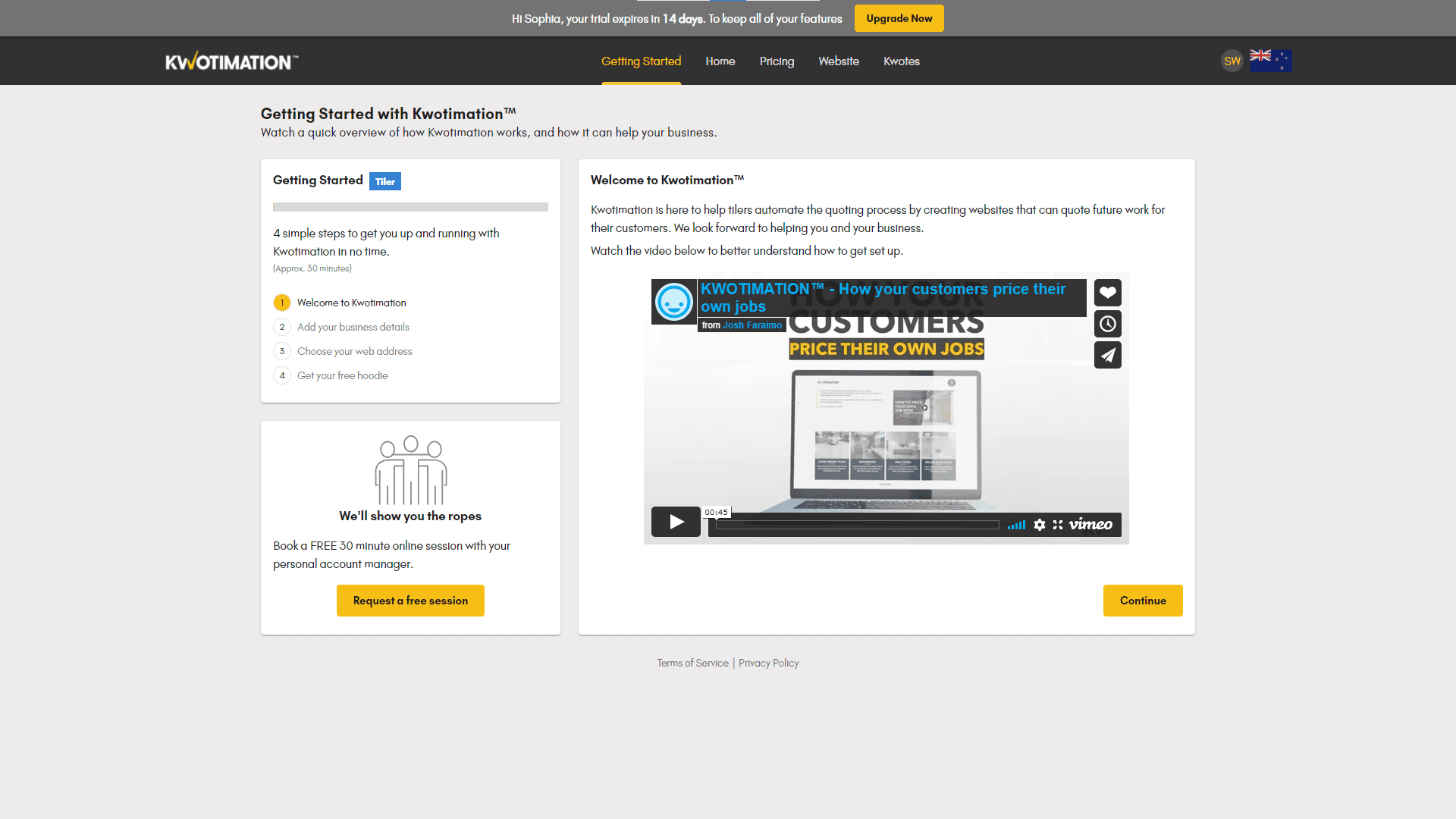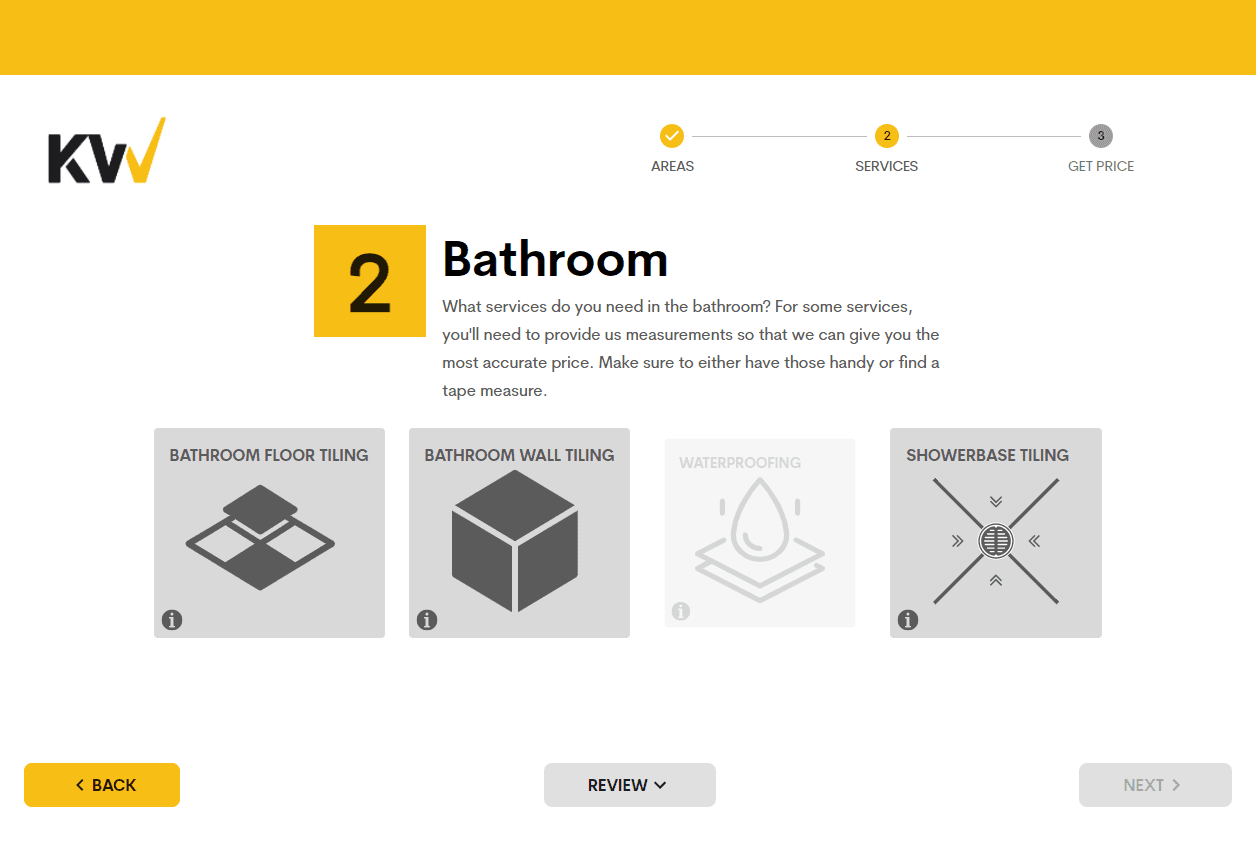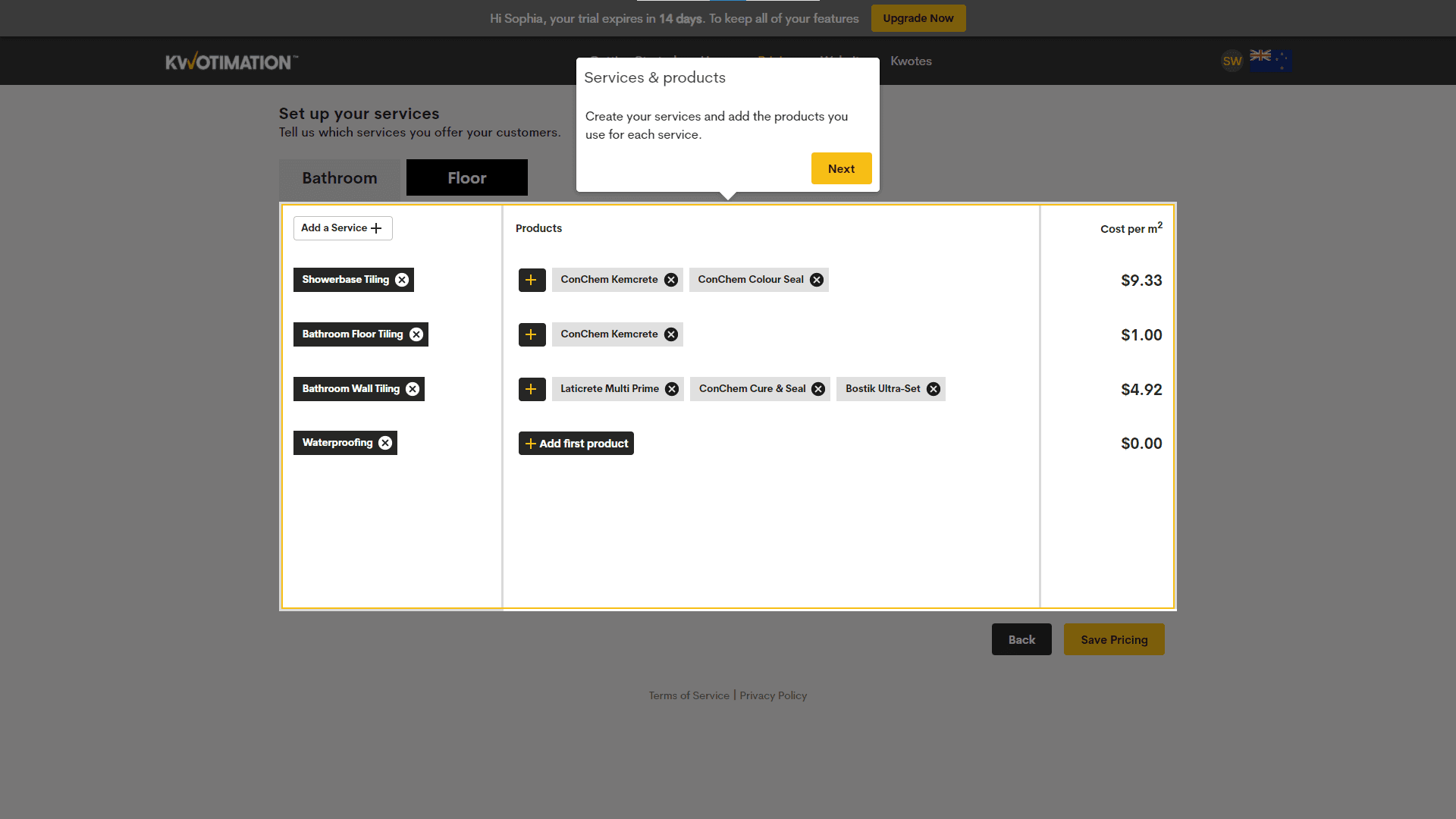Kwotimation™
Big tech for a humble industry. Kwotimation builds the 'Online Pricing System', which automates tradespeoples' quoting process. The OPS boosts tradies' business, cuts down on CO2 emissions, and redistributes wealth by empowering a sector of workers who have been left behind by the digital revolution.
Psst!
Once you're done reading this, I wrote a follow up blog post covering what I did at Kwotimation during the year after. Check it out by following this link.
Context
Prior to founding Kwotimation, Josh & Jarome were running a tiling business. They found that quoting jobs for prospective customers was consuming 10 hours of time per week, and that a third of their quotes were being rejected. The quoting side of the business was the bit that was most frustrating and disappointing. Figuring out a way to cut down on waste from the quoting process was an obvious way to build their business and maintain their sanity.
They contracted an overseas development shop in order to build out the first version of the 'Online Pricing System' and over the next 3 months their new website generated 120 quotes, of which 43 were accepted by customers. Recognizing that others in the tiling industry were suffering from the same problems they had with quoting, Josh & Jarome decided to "white label" their quoting solution, and founded Kwotimation.
The overseas developers they had been working with weren't up to the task of building a SaaS product, and so the founding team changed their development team and contracted with a small team of developers based in Wellington, New Zealand. Progress was slow, and the delivered features were buggy and incomplete. Despite their success with investors, Kwotimation was in very real danger of never getting to market due to development issues.
Josh & Jarome were looking for someone who could take end-to-end ownership of the development process, who could ensure that the product's features were built, polished, tested, and delivered on time. I joined Kwotimation on 2nd November 2020 as that person.
The problems
Prior to starting full-time work at Kwotimation, I had been overseeing the development of their software's "ad center" functionality. Due to this I had a good idea of what needed to be done, and what the pain points of the business were going in.
The key issues included:
- No project governance which resulted in a ballooning scope, poorly defined requirements, and a lack of communication between engineering and the founding team
- Lack of technical expertise within the team
- Zero documentation & test coverage, reducing developer agility
- Over-reliance on manual processes, causing hard-to-debug issues in production as a result of flaky manual deployments and configuration management
Our first action point was to downsize the development team, and properly scope out the project. The founders and I had long discussions about the required functionality, target user personas, and design requirements. We agreed to a project roadmap which aimed to have the MVP built in a little over one month from my start date.
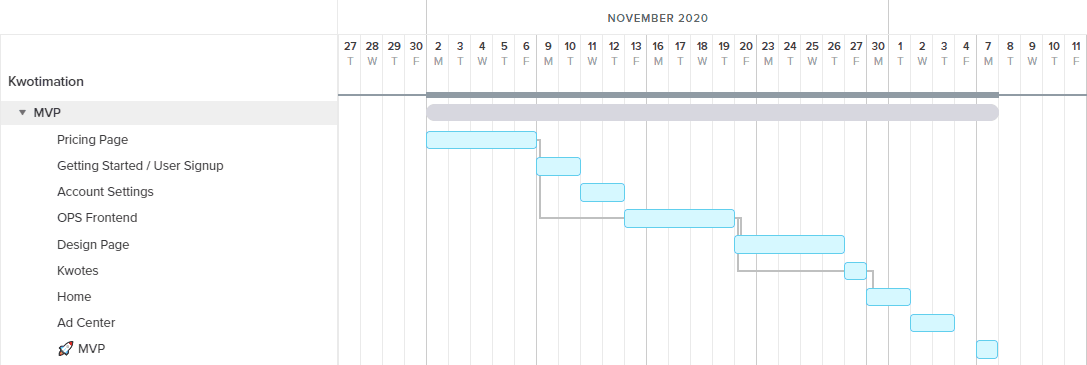
This was an ambitious timeline, but it was crucial for Kwotimation to get to market sooner rather than later so that they could maintain investor confidence and set themselves up for success with their second funding round the following year. Having built CRUD dashboards in the past, I knew that—at the very least—the tiler's interface would be straightforward to build out.
Starting off on the right foot
Kwotimation was already using an attractive tech stack, and so I spent my first week installing infrastructure and a project management framework in order to support the development process, and provide transparency to the founders.
It took Kwotimation's previous developers about three days to deploy changes, due to a reliance on performing deployments by hand. CI/CD is a vitally important piece of the puzzle for any serious software endeavor, as a properly configured pipeline (with accompanying test suites and developer rigor) allows businesses to have higher confidence in the quality of their code, and enables the ability to ship code fast. Through automation of deployments, it became possible to accomplish same-day turnaround for new features, tightening the dev-QA feedback loop.
The frontend of the product was also in need of a touch up. The first version of the Kwotimation software had been designed by a member of Josh's family, and was missing some flair. Due to time constraints we redesigned the software on-the-fly, taking cues from other software tradies are familiar with such as Fergus, Tradify, and Xero.
Finishing off the MVP
Beyond frontend changes and installing a DevOps culture, we also had a number of functional requirements which needed to be present in the MVP. The previous developers had built out some foundational components, such as a user accounts system and the beginnings of a system for tilers to input their pricing information—but there was a substantial number of missing features.
While the tiler's dashboard was in relatively good shape, their website was virtually non-existent in the code I was given. We had to build that out basically from scratch, and one of the design requirements was to allow tilers to edit their websites using a 'what-you-see-is-what-you-get' editor. These types of editors are historically quite difficult to create.
As we were using React for the frontend, however, implementing this functionality was much easier than it would have been otherwise. React's embrace of composition and declarative programming makes it easy to design UIs with an "edit mode" and a "presentation mode", so long as the data flows in the application make sense.
Another feature identified as critical was to allow customers the ability to resume the process of building their quote if they dropped off. Mobile phones account for about half of all web traffic, and this needs to be accounted for when building products, as these users are operating on patchier internet connections and are more likely to context switch compared to computer users.
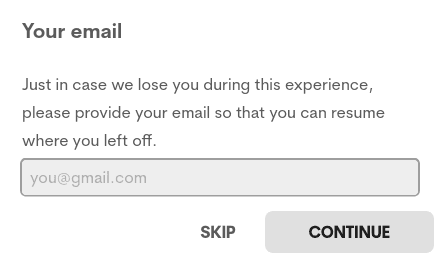
Allowing users to resume their quotes at a later time after they've swapped to a different app means that tilers are less likely to lose that customer, and by collecting their email upfront, we're even able to reach out to them and attempt to win them over through email remarketing.
Great, reliable software that people will part with their money to use isn't just a bag of features, however. There are a number of other pieces of the puzzle involved in order to bring the product to a shippable state. Below is a list of some of the major things we got done between November 2020 and January 2021.
- Converted 80% of the codebase to TypeScript, improving type safety and making refactors less intimidating
- Simplified the system's data flows by making better use of React hooks and replacing some outdated software packages with newer, easier-to-use alternatives.
- Added code for tracking analytics in order to keep on top of KPIs and determine when things aren't working well (because your users won't tell you that—they'll just stop using the product)
- Undertook massive reworks regarding data validation and exception handling, as when I was first put in charge of the system the API performed no server-side validation of its inputs, and would often hang forever instead of returning an error when things went wrong. This behavior is unacceptable from both a cybersecurity and UX perspective.
- Added robust CI/CD infrastructure which ensures merge requests don't break any tests, and that the latest and greatest code is continuously pushed out to development
- Improved the operations story, by integrating with APM (Sentry), website monitoring (Pingdom), and developing an incident management playbook.
- Wired up logic for managing user subscriptions. Stripe makes this incredibly easy to do nowadays, with their Checkout and Customer Portal offerings.
Business-to-Business...to-Customer
One of the unique difficulties with building Kwotimation's Online Pricing System comes from how it is targeted towards to very different types of end users. When designing the system, the needs of tilers (the paying subscribers) need to be delicately balanced against the needs of tiling consumers (the folks using the system to get a quote).
These two groups have different levels of computer expertise, expect to get different outcomes from the software, and have vastly different levels of knowledge about tiling. Figuring out how to build software that appeals to both groups, and which values each of their different perspectives is really difficult, especially in this case where the tilers purchasing the Kwotimation system aren't actually sure what they want from technology.
90% of the tilers interviewed during product validation did not have a website, and primarily relied on word of mouth and referrals to win clients. The possibility of using technology to streamline their business (and particularly, their quoting) hadn't really occurred to them before Kwotimation was pitched to them, and when users are unsure of a product or are presented with something new it is really easy to dismiss it out of hand. The value proposition for these tilers had to be really clear, and really compelling.
And then on the customers' front, we had to consider what they were looking for from the software. Tiling has a lot of jargon—like 'splashback', or 'mitered edges'—how do we ensure that these terms will be understood by an end user? How do we set users up for success, even if they might put in the wrong measurement for a service they want? How can we satisfy their desire to shop around for the lowest price, while also not alienating tilers who (rightfully!) don't want their industry to devolve into a race to the bottom, like so many other industries which have been 'disrupted' by technology?
There's no easy, clear cut answer to the questions we had to grapple with while designing the product. But something which did come up quite a bit during our discussions was the value of transparency. If a customer does wind up submitting an incorrect measurement, for instance then our system can actually still be valuable! The tiler is able to go through and use the OPS to generate a price for the customer using the corrected measurements, and the customer has piece of mind knowing that the tiler isn't just inventing a new number out of thin air. There's transparency between the customer and the tiler about the tiler's pricing which simply didn't exist previously, and both of them are better off for it.
Thinking about issues from another angle and playing devil's advocate like that is a useful exercise, as it can illuminate the other, less obvious value-adds that all products have, but which purchasers might not be able to see unless it's proactively brought to their attention.
The path forward
After completing the MVP at the beginning of December, Kwotimation opened up the software to a representative sample of the tilers they had been in talks with throughout development. These tilers provided feedback on the first iteration of the system, and we used that feedback in order to further improve Kwotimation's product in order to get it ready for a proper launch in January 2021.
Encouragingly, tilers were highly enthusiastic about the software when testing it out. Interviews with tilers earlier in the year had indicated that almost all tilers saw quoting as a chore that sucked up their time and prevented them from engaging in activities they found more meaningful—like growing their business, or hanging out with family. The 'only' thing Kwotimation had to do was establish product/market fit. The positive reception from the test group gave us confidence that we were on the right track.
We received some useful feedback around the software's tiling model, and went on to add additional services for tilers to customize. We also ran into some problems with our approach to onboarding—and so we tweaked our feature tours in response to feedback until we found that tilers were able to make it through unassisted.
Key takeaways
The most important task for a founder (after validating their product idea) is to build a great team that can execute a strategy and bring their idea to fruition. Choosing the right people for the job is the difference between success and failure, and when you're at an early stage with limited resources you need to find the right people fast.
To make things harder, the people you hire will also need to be able to wear a variety of different hats competently. At Kwotimation, I wasn't just responsible for development—I also had to project manage, liaise with investors (both current and potential), set up and manage infrastructure, optimize the software's UX, and assist with talent acquisition.
When hiring for your early stage startup try to get as many 'nice-to-haves' as possible with each new team member, and treat employee due dilligence as though your business depends on it.
After getting a solid team on board, it's then time to keep talking to your target audience, and maintain strong relationships with them. Having these people in your Rolodex not only means you have people to try and sell to, but it also means that you can continuously revalidate your product and check that you're still making good decisions. A lot of great companies wind up falling flat due to a lack of focus on what matters to their customers, and ballooning project scope. By keeping your audience keyed in to your doings, you can hold yourself accountable to them and tighten up the feedback loop.
